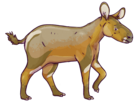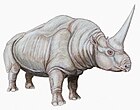Palaeosyops: Difference between revisions
No edit summary |
Painting instead of photo of same skull. |
||
| (One intermediate revision by one other user not shown) | |||
| Line 3: | Line 3: | ||
| fossil_range = {{Fossil range|Early Eocene|Middle Eocene}} |
| fossil_range = {{Fossil range|Early Eocene|Middle Eocene}} |
||
| image = Palaeosyops.jpg |
| image = Palaeosyops.jpg |
||
| image_caption = '' |
| image_caption = ''P. robustus'' skeleton |
||
| taxon = Palaeosyops |
| taxon = Palaeosyops |
||
| subdivision_ranks = Species |
| subdivision_ranks = Species |
||
| Line 11: | Line 11: | ||
}} |
}} |
||
'''''Palaeosyops''''' (Greek: "old" (paleos), "boar" (kapros), "face" (ops)<ref>{{cite web|url=https://research.amnh.org/paleontology/perissodactyl/concepts/glossary|archive-url=https://web.archive.org/web/20211120123130/https://research.amnh.org/paleontology/perissodactyl/concepts/glossary|archive-date=20 November 2021|title=Glossary. American Museum of Natural History}}</ref>) is a genus of small [[brontothere]] which lived during the early to middle [[Eocene]].<ref>{{cite web | url= |
'''''Palaeosyops''''' (Greek: "old" (paleos), "boar" (kapros), "face" (ops)<ref>{{cite web|url=https://research.amnh.org/paleontology/perissodactyl/concepts/glossary|archive-url=https://web.archive.org/web/20211120123130/https://research.amnh.org/paleontology/perissodactyl/concepts/glossary|archive-date=20 November 2021|title=Glossary. American Museum of Natural History}}</ref>) is a genus of small [[brontothere]] which lived during the early to middle [[Eocene]].<ref>{{cite web | url=https://paleobiodb.org/classic/checkTaxonInfo?taxon_no=43053 | title=Fossilworks: Palaeosyops }}</ref> |
||
==Biology and size== |
==Biology and size== |
||
[[File:Palaeosyops AMNH.jpg|left|thumb|''P. robustus'' skull collected from Bridger Basin, [[Wyoming]] |
[[File:Palaeosyops AMNH.jpg|left|thumb|''P. robustus'' skull collected from Bridger Basin, [[Wyoming]] with model by [[Erwin S. Christman]], [[American Museum of Natural History|AMNH]].]] |
||
It was about the size of small [[cattle]], with a weight of 600–800 kg depending on the species.<ref>{{cite web |url=http://museumu03.museumwww.naturkundemuseum-berlin.de/cgi-bin/bridge.pl?a=basicTaxonInfo&taxon_no=49708 |title=Paleobiology Database: Palaeosyops robustus |accessdate=2012-06-03 |url-status=dead |archiveurl=https://archive.today/20121210125809/http://museumu03.museumwww.naturkundemuseum-berlin.de/cgi-bin/bridge.pl?a=basicTaxonInfo&taxon_no=49708 |archivedate=2012-12-10 }}</ref> |
It was about the size of small [[cattle]], with a weight of 600–800 kg depending on the species.<ref>{{cite web |url=http://museumu03.museumwww.naturkundemuseum-berlin.de/cgi-bin/bridge.pl?a=basicTaxonInfo&taxon_no=49708 |title=Paleobiology Database: Palaeosyops robustus |accessdate=2012-06-03 |url-status=dead |archiveurl=https://archive.today/20121210125809/http://museumu03.museumwww.naturkundemuseum-berlin.de/cgi-bin/bridge.pl?a=basicTaxonInfo&taxon_no=49708 |archivedate=2012-12-10 }}</ref> |
||
These animals are commonly found in [[Wyoming]] fossil beds primarily as fossilized teeth. ''P. major'' was the largest species, reaching the size of a small cow. Its describer, [[Joseph Leidy]], erroneously thought that ''Palaeosyops'' consumed both plants and animals after examining the fang-like canines. However, it is now known that all brontotheres were strict herbivores, and that many, if not most genera of hornless brontotheres had fang-like canines, possibly for both defense from predators, and intraspecific competition. |
These animals are commonly found in [[Wyoming]] fossil beds primarily as fossilized teeth. ''P. major'' was the largest species, reaching the size of a small cow. Its describer, [[Joseph Leidy]], erroneously thought that ''Palaeosyops'' consumed both plants and animals after examining the fang-like canines. However, it is now known that all brontotheres were strict herbivores, and that many, if not most genera of hornless brontotheres had fang-like canines, possibly for both defense from predators, and intraspecific competition. |
||
[[File:Palaeosyops |
[[File:Palaeosyops by Knight.jpg|left|thumb|Restoration by [[Charles R. Knight]]]] |
||
== References == |
== References == |
||
| Line 35: | Line 35: | ||
[[Category:Eocene mammals of North America]] |
[[Category:Eocene mammals of North America]] |
||
[[Category:Prehistoric placental genera]] |
[[Category:Prehistoric placental genera]] |
||
{{paleo-oddtoedungulate-stub}} |
{{paleo-oddtoedungulate-stub}} |
||
Latest revision as of 20:15, 4 January 2025
| Palaeosyops Temporal range:
| |
|---|---|

| |
| P. robustus skeleton | |
| Scientific classification | |
| Domain: | Eukaryota |
| Kingdom: | Animalia |
| Phylum: | Chordata |
| Class: | Mammalia |
| Order: | Perissodactyla |
| Family: | †Brontotheriidae |
| Genus: | †Palaeosyops |
| Species | |
| |
Palaeosyops (Greek: "old" (paleos), "boar" (kapros), "face" (ops)[1]) is a genus of small brontothere which lived during the early to middle Eocene.[2]
Biology and size
[edit]
It was about the size of small cattle, with a weight of 600–800 kg depending on the species.[3]
These animals are commonly found in Wyoming fossil beds primarily as fossilized teeth. P. major was the largest species, reaching the size of a small cow. Its describer, Joseph Leidy, erroneously thought that Palaeosyops consumed both plants and animals after examining the fang-like canines. However, it is now known that all brontotheres were strict herbivores, and that many, if not most genera of hornless brontotheres had fang-like canines, possibly for both defense from predators, and intraspecific competition.

References
[edit]- ^ "Glossary. American Museum of Natural History". Archived from the original on 20 November 2021.
- ^ "Fossilworks: Palaeosyops".
- ^ "Paleobiology Database: Palaeosyops robustus". Archived from the original on 2012-12-10. Retrieved 2012-06-03.










